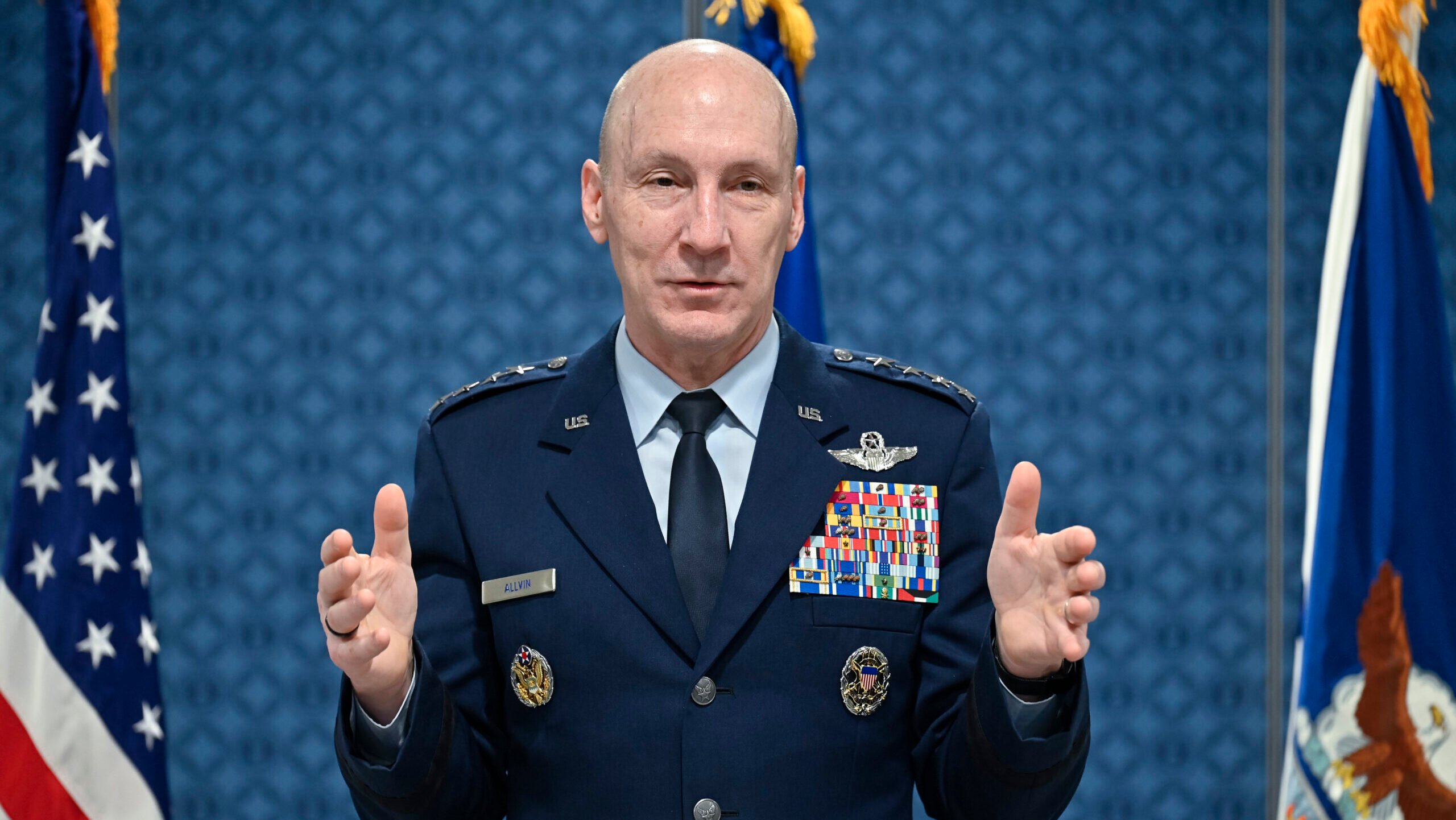
Air Force Chief of Staff Gen. David W. Allvin makes remarks in a Feb. 7, 2024 file photo. (U.S. Air Force/Eric Dietrich)
WASHINGTON — Funding constraints combined with rapid development of new drone technology has the Air Force openly questioning the fate of its planned sixth-gen stealth fighter, according to the service’s top uniformed officer.
“The deliberations are still underway, there’s been no decision made. We’re looking at a lot of very difficult options that we have to consider,” Air Force Chief of Staff Gen. David Allvin said today in a roundtable with reporters at the Pentagon, when asked about the service’s plans for its Next Generation Air Dominance (NGAD) fighter.
Delaying or outright canceling NGAD would represent a stark reversal for the Air Force, which officials like Secretary Frank Kendall have previously called a “vital element” of the “family of systems” the service is pursuing to dominate rival militaries, particularly China. Planned to replace the F-22, the NGAD platform is expected to be extremely expensive, likely several times the cost of an F-35. Lockheed Martin and Boeing are thought to be competing to build it.
Until this week, NGAD seemed to be largely on track as a program, with the Air Force previously announcing its “intent” to award a contract for the effort this year. But in the last 24 hours, the service’s top two officials have both floated the idea that the manned, sixth-gen fighter may be in danger.
Allvin first revealed on Thursday that the Air Force might be having second thoughts, when asked directly whether the service could still field it as planned. The general didn’t commit to the program, suggesting instead that it was one of several “choices” officials had to make for its fiscal 2026 budget request.
Shortly after, Aviation Week published a story with Kendall, who said officials have to be “open-minded” about the program due to funding constraints. The service has many competing priorities, including the B-21 Raider and Sentinel ICBM whose costs have ballooned.
During his comments today, Allvin noted another factor that has gone into the potential rethink of NGAD: a better understanding of how unmanned systems fit into future concepts of operation.
He explained that by “leaning into” the Air Force’s Collaborative Combat Aircraft (CCA) drone wingman effort, the service is “discovering” a “different way of developing capabilities.” Specifically, the Air Force’s vision for CCA — where the drones would be capable of quickly evolving to meet new threats — can serve as a “pathfinder” for many of the service’s new initiatives, shifting focus away from long-term platforms envisioned to win fights decades into the future.
“We don’t tack on extra requirements like Christmas tree ornaments that make them so much more expensive. We don’t add a sustainment tail that you have to build a depot structure [for] and you’re going to have block upgrades and everything — no, because the assumption is that the technology is going to move fast enough that if you can fit that technology into the current form factor because it’s modular, great. If not put that aside,” Allvin said of CCA.
“It’s the systems that make the difference,” he continued. “So privileging design rather than very expensive hardware that is so expensive you can’t afford enough of them to be able to use, I think is one of the areas that we’re pursuing in several of the capabilities we’re developing.”
Allvin also noted that a “Century Series” concept championed by former Air Force acquisition czar Will Roper, where fighters would have iterative designs capable of changing every few years in response to threats, is “not dissimilar” from how the service is thinking about the future. Emphasizing that considerations like cost and requirements must stay in the mix, Allvin said, “we will see how fast industry can deliver.”
A move toward rapidly iterated designs and short sustainment tails would likely upend industry’s business model, which often depends on long, lucrative contracts to maintain systems. Allvin suggested that for newer platforms, their lifespan might not be as long as their predecessors.
“I often joke about ‘built to last.’ Maybe ‘built to last’ isn’t a good bumper sticker anymore, because built to last assumes that it’s relevant as long as it lasts,“ he said.
"difficult" - Google News
June 15, 2024 at 04:25AM
https://ift.tt/ItY7ylD
Allvin: ‘No decision’ made on NGAD, but ‘difficult’ choices loom - Breaking Defense
"difficult" - Google News
https://ift.tt/dEeMj2W
https://ift.tt/rDBv6Yf
Bagikan Berita Ini














0 Response to "Allvin: ‘No decision’ made on NGAD, but ‘difficult’ choices loom - Breaking Defense"
Post a Comment